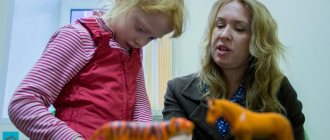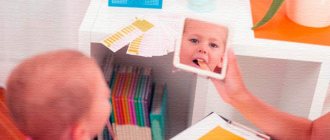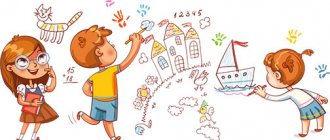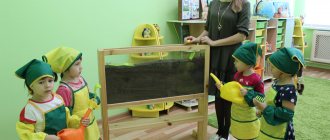Development of speech understanding. Consultation on speech therapy on the topic
Development of speech understanding.
An important area of pedagogical work with young children is the creation of conditions for speech development. In this area, several specific tasks stand out: the development of active speech, speech understanding, the formation of phonemic hearing, the development of speech as a means of controlling one’s behavior (that is, the planning and regulatory functions of speech).
To develop understanding of speech, it is necessary to awaken and maintain children’s interest in audible speech and develop the ability to listen to the speech of an adult. Developing understanding of speech implies establishing an adequate connection between a word and an object and an action. In this process, an important role is played by encouraging children to carry out adult verbal instructions of varying complexity: from the simplest one-step ones for young children (“give”, “show”, “take”, “bring”, etc.) to more complex (as the child gets older) two- and three-step instructions.
There are several levels of development of speech understanding in children with speech underdevelopment:
- Zero: a child with intact hearing does not perceive the speech of others, sometimes reacts to his name, less often to intonations of prohibition or encouragement;
- Situational: the child understands requests related to the everyday objective world. He knows the names of loved ones and the names of his toys, can show body parts of himself, his parents, or a doll, but upon verbal request he does not distinguish between images of objects, toys, that are well known to him.
- Nominative: the child is well versed in the names of objects depicted in the pictures, but has difficulty naming the actions depicted in the plot pictures. Completely does not understand questions of indirect cases (With what? To whom? With whom?...)
- Predicative: the child knows many names of actions, easily navigates questions of indirect cases posed to the objects of actions depicted in plot pictures, distinguishes the meanings of several simple prepositions (put on the box, in the box, near the box). Does not distinguish between grammatical forms of words.
- Dissected: the child distinguishes changes in meanings introduced by individual parts of the word (morphemes) - inflections (endings), prefixes, suffixes.
When does a child’s understanding of speech begin to develop? From 5-6 months, children become more active. It is during this age period that the main task is to develop children’s understanding of speech and the ability to repeat syllables after adults. The mother should name the objects surrounding the child and the actions performed by the child or the mother herself. Thus, she combines objects and actions with their verbal designation. You can play the following games:
“Where is Lyalya?” Target. Develop the ability to find a named object using a word (after 7 months). For the lesson, large story toys are used (doll, cat, dog, rooster, hare, etc.), which must always be in the same place so that the baby can see them all the time.
"Rhymes" Purpose. Develop an understanding of the names of simple movements and imitation of movements, for example, “Okay”, “Goodbye”, “Give me a pen” (from 7 months).
"Roll Call" Purpose. Development of the articulatory apparatus and the ability to imitate (from 7-8 months).
"Hide and Seek" Goal. Introduce the child to his name and the names of other children and adults (from 8-9 months). “Where is Masha? No Masha."
From 9-10 months to 1 year, the number of words and sentences a child understands increases. You should teach the child to perform certain movements according to the word (sit down, stand up) and perform a number of different actions with objects (put one cube on another, remove and put a ring on a stick - “put it on,” “take it off,” “put it on”).
It is necessary to create a speech environment. This means the following: you need to constantly talk to the child, repeatedly talking through all routine moments (dressing and undressing, washing, eating, walking, getting ready for bed), and various everyday situations (putting toys in places, preparing food, clearing the table, etc. .). The same work should be done while playing with toys and pictures, and while reading books.
At the same time, the adult speaks in simple short sentences of 2-4 words, uses the same phrases several times, pauses, uses different intonations, and different voice strengths. Words are pronounced clearly, with emphasis on the stressed syllable, for which the stressed syllable is slightly stretched.
An adult often turns to the child and asks questions. But you should not demand an immediate answer. Thus, the adult asks a question, pauses, then answers the question himself.
In the process of correctional classes for the development of speech understanding, the main task is the accumulation of children’s passive vocabulary: words - objects, words - actions, as well as words denoting certain phenomena and states.
Groups of words suggested for memorization.
1. Subject dictionary.
Toys: ball, cube, car, doll, bear, bunny, ball, spinning top, bucket, shovel, pencils, book, etc. Parts of the body, face: legs, arms, belly, back, finger, head, neck, hair, eyes , ears, mouth, lips, teeth, nose, cheeks, eyebrows, forehead. Clothing and footwear: hat, scarf, mittens, jacket, coat, dress, skirt, jacket, shirt, trousers, tights, briefs, T-shirt, socks, slippers, boots, shoes, sandals, etc. Toilet items: soap, toothbrush, toothpaste, sponge, towel, comb, handkerchief, etc. House, apartment: house, door, lock, key, stairs, elevator, window, kitchen, room, bathroom, lamp, floor, ceiling, wall, etc. Furniture: table, chair, sofa, bed, wardrobe, shelf, hanger, etc. Household items: TV, telephone, clock, stove, refrigerator, fork, spoon, plate, cup, blanket, pillow, mirror, etc. Food and dishes : bread, bun, cheese, sausage, sausages, milk, butter, sour cream, cottage cheese, yogurt, cookies, juice, egg; porridge, soup, salad, sandwich, tea, compote, etc. Vegetables and fruits: cabbage, potatoes, carrots, onions, cucumber, tomato; orange, banana, apple, pear, plum, etc. Plants: tree, bush, grass, flowers, berries, etc. Names of animals and birds that the child often sees: dog, cat, bird, dove, sparrow, crow, horse, etc. etc. Separate names of objects of surrounding life: street, road, traffic light, cars, plane, swing, slide, park, etc. Separate names of phenomena of surrounding life: water, earth, sun, sky, rain, snow, night, day, etc.
2. Verb dictionary.
The child’s own actions: walks, sits, stands, runs, jumps, sleeps, eats, plays, draws, builds, walks, rolls, washes, bathes, dresses, undresses, combs his hair, carries, falls, screams, speaks, sweeps, wipes and etc. Names of actions that people close to the child perform: reads, writes, draws, cleans, washes, irons, cooks, fries, sweeps, etc. Other actions: the phone rings; the car drives and hums; The plane is flying; leaves are falling, etc.
3. Adjectives, adverbs.
Names of some sensations and states: sweet, salty, sour, wet; cold, warm, hot, painful, tasty.
The name of some concepts: big, small; a lot, a little.
Sequence of work on speech understanding.
The basic rule that is absolutely necessary to follow for successful understanding of speech: the correlation between a word and what it means should be as obvious as possible for the child.
Classes begin with the child being taught to understand a word in a certain situation. Usually these are words - nouns, then verbs, then simple signs. Acquaintance occurs gradually, preferably in a specially organized game, then it is consolidated in everyday life. The most convenient and interesting game is hide and seek. During this game, an object, for example, a toy, appears and disappears multiple times while naming it at the same time.
Dictionary accumulation sequence:
Nouns.
- The object is presented and named.
- The child is introduced to the purpose of the object.
- A game is organized during which the object is called repeatedly (for example, hide and seek: “Here is the ball! They hid the ball! There is no ball! Where is the ball? Here is the ball! Throw the ball to mom!”).
- A child uses a word to find an object when choosing from two.
- The child finds an object upon request, choosing it from a larger number of objects.
- To form a concept, the child is offered similar, but different in color, size, texture objects and their images.
- The name of the object is included in games and songs, and work begins on including the word in the child’s active vocabulary.
Note: we proceed to each subsequent point only after the child copes with the previous one.
Verbs.
- Introducing the child to an action or a picture depicting an action. For example, familiarity with the verb “eats”.
- A game is organized, during which this action is played out many times and called (“the bear eats, the bunny eats, the doll eats”).
- The child chooses one of two actions (the doll eats - the doll sleeps).
- Choose from more options.
- Incorporating words into everyday life and games.
- Including a word in the active dictionary.
Acquaintance with other parts of speech occurs using a similar method.
Working on a proposal:
Types of simple sentences:
- Instructions: Give me the machine.
- Descriptions: Give me a big car.
- Questions: Do you want a car?
- Negatives: Is this a machine? (show the cube).
Complication occurs after working out a simple sentence. The difficulty will depend on the number of words that affect understanding, the so-called keywords.
When working on understanding speech, it is necessary to use sentences of different types, the words in them must perform different functions. For example,
- Accessory: “Wash the car plate.”
- Moving an object: “Put the car on the table.”
- Passing the object: “Give me the ball.”
- An action performed on a subject or object: “Pet the dog.”
- Questions: “Where is the bear?”
- Negations: “Show me a bear that doesn’t lie.”
So, to develop speech understanding it is necessary:
- help the child establish connections between objects and actions, on the one hand, and the words denoting them, on the other;
- expand the child’s orientation in the environment;
- teach your child to recognize familiar objects even in unfamiliar surroundings;
- teach the child to recognize objects in nature and in pictures that are similar, but different in color, size or shape;
- encourage the child to carry out various instructions at the request of an adult (bring, show);
- teach the child to understand the content of simple sentences;
- teach the child to understand the display of simple plots, accompanied by the words of an adult.
Diagnostics
Patients with impressive speech disorders require comprehensive neurological, audiological, speech therapy, psychological and psychiatric diagnostics, consultation with relevant specialists:
- Neurological examination.
At an appointment with a neurologist, perinatal risk factors and features of early development of children are clarified; In all patients, the current neurological status is determined. To understand the etiology of speech disorders, instrumental diagnostics are prescribed: cerebral MRI scanning, MR arteriography of the brain, EEG, ultrasound scanning of the vessels of the head and neck. - Examination of auditory function.
To exclude hearing loss as the main factor in misunderstanding speech, acoustic EPs, an audiogram are examined, acoustic impedance measurements are performed, and CT scans of the temporal bones are performed. Along with an examination by an otolaryngologist, a consultation with an audiologist is carried out. - Neuropsychological testing.
Involves the study of higher mental functions (memory, perception, thinking), auditory-verbal memory. During diagnosis, attention is paid to the state of various types of gnosis and praxis. A conclusion is made about the patient's cognitive abilities. - Speech therapy examination.
When analyzing speech function, the speech therapist conducts an in-depth study of impressive speech. Evaluates the patient's understanding of situational and extra-situational questions, verbal instructions, and complex prepositional phrases. Examines phonemic awareness, meaningful reading ability, and expressive language. - Consultation with a psychiatrist.
Necessary for assessing the patient’s mental status, excluding congenital forms of MR, acquired dementia, and ASD. The methods used are conversation, observation, pathopsychological examination, neurotests.
Logotherapy



